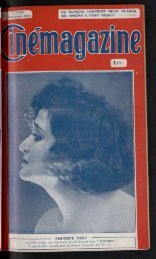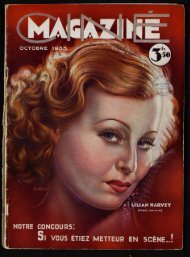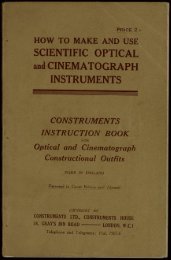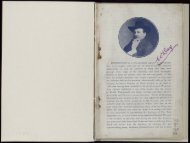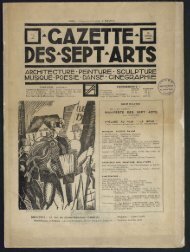Untitled
Untitled
Untitled
Create successful ePaper yourself
Turn your PDF publications into a flip-book with our unique Google optimized e-Paper software.
52 MODERN MAGIC LANTERNS. THE LANTERN BODY. 53<br />
back by which to introduce the illuminant, and a curtain<br />
should hang loosely round the back of the lantern, and<br />
cut off the stray light which would otherwise escape<br />
thence into the room. The doors usually are provided<br />
with a little window glazed with red or blue glass, so<br />
that the working of the lamp can be observed. These<br />
windows are not of much use, most operators preferring<br />
to look at the naked light itself, but they might be made<br />
more suitable by being both larger and glazed with, say, a<br />
deep red and blue, or a very dark neutral-tinted glass. This<br />
becomes a necessity with the arc lamp, which cannot be<br />
watched through the usual windows at all. With the arc<br />
lamp care must be used that at no time either carbon<br />
holder or other part conveying current is brought into<br />
contact with the metal lining of the lantern body.<br />
The base of the lantern is best a perfectly flat board, with<br />
an arrangement such as that shown in Fig 40, by which<br />
the entire apparatus can be tilted up or down. The base<br />
should be stood for<br />
use upon an equally<br />
flat surface, bearing<br />
in mind that the<br />
slightest motion of<br />
Fig. 40. TILTING STAND FOR THE LANTERN.<br />
the lantern will be<br />
enormously magnified<br />
upon the screen.<br />
The holes by which air is admitted to the lantern are best<br />
placed at the bottom of each side, and with oil lamps<br />
especially should be of ample size, and must be seen to be<br />
perfectly free. Nothing helps so much to keep a lantern<br />
cool and in the best working order as a regular and ample<br />
current of air passing right up through it, but not a draught<br />
or irregular one which may endanger the condenser.<br />
For all ordinary purposes a single lantern is sufficient.<br />
It is much the easiest to work, has less to get out of order,<br />
and is less expensive both in prime cost and in working.<br />
For photographic slides, for enlarging, and for scientific<br />
demonstrations it is all that is required. When, however, that<br />
gradual melting of one picture into another known as<br />
dissolving is desired, two lanterns, which when placed one<br />
above the other are known as a binnial (Fig 41), are necessary.<br />
The dissolving is effected with limelight by turning one<br />
jet down and the other up, with lamps, by moving a notched<br />
screen be1or3 one of the lanterns and simultaneously remov-<br />
Fig. 41. A B1UNIAL LANTERN.<br />
ing a similar screen from the other ; as shown in Fig. 42, A A<br />
being the objectives of the two lanterns. For what are<br />
called effects, in which sunlight fades into moonlight, buildings<br />
are illuminated, curtains roll up or down to display or<br />
cover up the picture, and similar things, two, and often three<br />
lanterns are employed, the latter being known as a triunial.<br />
Much work is often lavished on these structures, in the<br />
shape of bright brass rods and fittings, rendering them most<br />
costly luxuries ; but essentially they should consist of three<br />
lanterns, each possessing in itself the most desirable features<br />
of an efficient single lantern, the only really necessary extra



